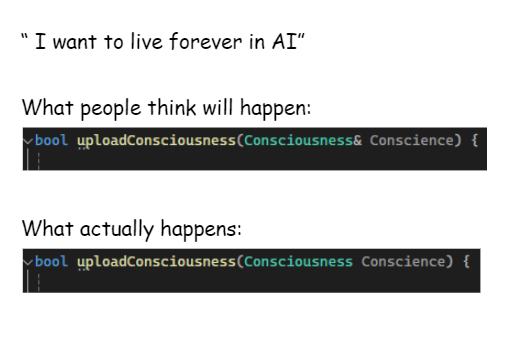this post was submitted on 25 Apr 2024
702 points (95.5% liked)
Programmer Humor
19289 readers
1431 users here now
Welcome to Programmer Humor!
This is a place where you can post jokes, memes, humor, etc. related to programming!
For sharing awful code theres also Programming Horror.
Rules
- Keep content in english
- No advertisements
- Posts must be related to programming or programmer topics
founded 1 year ago
MODERATORS
you are viewing a single comment's thread
view the rest of the comments
view the rest of the comments

Even if it were possible to scan the contents of your brain and reproduce them in a digital form, there's no reason that scan would be anything more than bits of data on the digital system. You could have a database of your brain... but it wouldn't be conscious.
No one has any idea how to replicate the activity of the brain. As far as I know there aren't any practical proposals in this area. All we have are vague theories about what might be going on, and a limited grasp of neurochemistry. It will be a very long time before reproducing the functions of a conscious mind is anything more than fantasy.
Counterpoint, from a complex systems perspective:
We don't fully know or are able toodel the details of neurochemistry, but we know some essential features which we can model, action potentials in spiking neuron models for example.
It's likely that the details don't actually matter much. Take traffic jams as an example. There is lots of details going on, driver psychology, the physical mechanics of the car etc. but you only need a handful of very rough parameters to reproduce traffic jams in a computer.
That's the thing with "emergent" phenomena, they are less complicated than the sum of their parts, which means you can achieve the same dynamics using other parts.
Even if you ignore all the neuromodulatory chemistry, much of the interesting processing happens at sub-threshold depolarizations, depending on millisecond-scale coincidence detection from synapses distributed through an enormous, and slow-conducting dendritic network. The simple electrical signal transmission model, where an input neuron causes reliable spiking in an output neuron, comes from skeletal muscle, which served as the model for synaptic transmission for decades, just because it was a lot easier to study than actual inter-neural synapses.
But even that doesn't matter if we can't map the inter-neuronal connections, and so far that's only been done for the 300 neurons of the c elegans ganglia (i.e., not even a 'real' brain), after a decade of work. Nowhere close to mapping the neuroscientists' favorite model, aplysia, which only has 20,000 neurons. Maybe statistics will wash out some of those details by the time you get to humans 10^11 neuron systems, but considering how badly current network models are for predicting even simple behaviors, I'm going to say more details matter than we will discover any time soon.
Yes the connectome is kind of critical. But other than that, sub threshold oscillations can and are being modeled. It also does not really matter that we are digitizing here. Fluid dynamics are continuous and we can still study, model and predict it using finite lattices.
There are some things that are missing, but very clearly we won't need to model individual ions and there is lots of other complexity that will not affect the outcome.